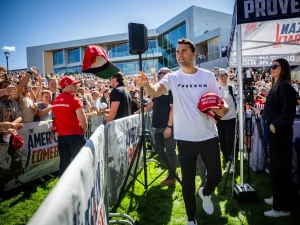Chargers or Raiders?
Profs take to the street to seek truth

October 15, 2015
Dr. Vassilis Dalakas, a die-hard Oregon Duck football fan and colleague Dr. Ben Cherry, an international soccer enthusiast, share a passion for sports and a curiosity about its fans.
Eighteen years ago, Cherry began exploring fandom at the University of Arizona.
Years later, Cherry found a partner in Dalakas at CSUSM.
“When Vassilis got here and I started hearing the things he was working on…we first started talking about it.”
The marketing professors decided that they wanted to research ingroup and outgroup bias and the world of fan identification that would lead them to understand why so many San Diegans love the home team and loathe the out-of-towners.
“The more identified and connected you are with one group, the more favorable you are going to see everything relating to that group,” which leads to dislike for other groups, like rival teams, said Dalakas.
For their study, which they conducted three years ago, they stayed true to local sports allegiances by choosing the San Diego Chargers as the ingroup and the Oakland Raiders as the outgroup.
Unlike common research methods, such as surveys, Dalakas and Cherry decided to take a real-world approach that triggered tangible emotions.
“There was the uncertainty element of what would happen, so we were both stressed in different ways” said Dalakas.
Dalakas and Cherry explored fan identification for two days during Week 7 of the 2012 NFL season. The Chargers were on a much needed bye week after a 24-35 loss to the Denver Broncos.
In the study, which is poised to make a journal entry later this year, Dalakas was a silent observer taking notes as Cherry stood on the street corner posing as homeless. Cherry spent time in an unmarked shirt, a Chargers shirt and a Raiders shirt, all the while taking notes on the back of his cardboard sign that read “Need Help.”
Cherry stood silently while avoiding eye contact, intent on ignoring responses from passers-by for the time being, in order to allow for natural interaction.
He said he was honest with those he spoke to. If people asked him questions, he tried to answer truthfully, while maintaining his cover.
The professors experienced both positive and negative interactions.
“I didn’t realize it was going to be that laboring,” said Cherry.
Dalakas said that the time Cherry spent in a Raiders shirt “couldn’t go fast enough.”
One common reaction was heightened negative feedback for Cherry while donning Raiders gear.
They each recall a driver traveling by at full speed, yelling “Raiders suck!”
Dalakas and Cherry learned that people were more likely to provide assistance if Cherry was not in Raiders gear, which reinforced the out group bias idea that they had based their study on.
Going beyond the Chargers vs. Raiders concept, the professors drew much more serious conclusions from their study.
“How do we treat humans that we either think are scary to us, or put some element of fear in us?” Cherry asked. “Just that kind of basic human interaction stuff—looking people in the eye, having genuine care and concern for someone else. I mean those things won’t probably show up ever in a journal article, but that’s certainly the stuff that sticks with me.”
Dalakas said social identities, while natural, can have serious effects.
“[They] can be extremely powerful, extremely influential and inevitably, as much as we are reluctant to admit that, they bias and prejudice the way with which we look at the world,” said Dalakas.






